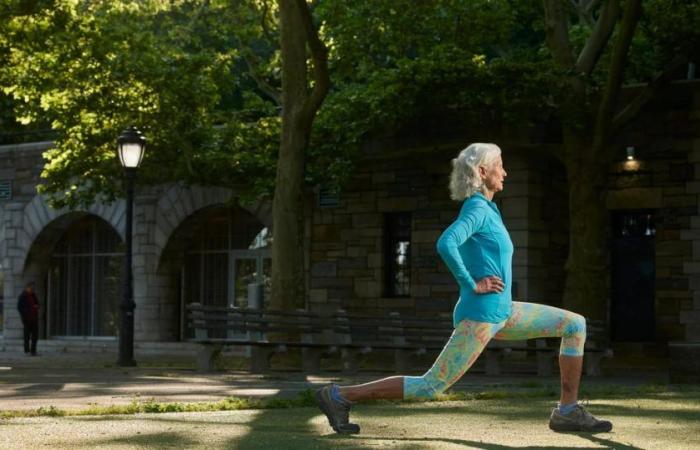ExerciseOsteoporosisMenopauseWomen and GirlsBonesBone FracturesAge, ChronologicalLongevityContent Type: Service
Women are more at risk than men of having their bones weaken. But some simple exercises can help keep your skeleton strong and resilient.
[Estamos en WhatsApp. Empieza a seguirnos ahora]
When Barbara Hannah Grufferman was in her early 50s, a bone densitometry revealed that she was on the path to developing osteoporosis. If she did not change her lifestyle, her bones would become increasingly brittle, putting her at high risk for life-altering spinal, hip, and other fractures.
Grufferman had always been active, running after her two daughters and walking her dog around Manhattan. But she hadn’t done much formal exercise since “the Jane Fonda days,” when she was about 20, she said.
When he learned of his low bone density, he began training to run the New York Marathon and doing planks and squats daily. He practiced standing on one foot whenever he could, to improve his balance. Today, more than 15 years later, her bone density has remained stable and she is training for her 18th marathon.
“I am a living example that it is never too late to act,” said Grufferman, 67.
But you don’t have to run marathons to protect your bones. Simply add a few strategic exercises to your routine to strengthen them, now and in the future.
“People think of bones as static,” said Andrea Singer, medical director of the Bone Health and Osteoporosis Foundation in the United States. But “it is a living and dynamic organ that is constantly remodeled.”
As with muscles, the more bones are strategically stressed with exercise, the stronger they become, he said.
Everyone’s bones weaken with age, but 80 percent of Americans with osteoporosis are women, and half of women over age 50 will break a bone because of the disease. Women reach their maximum bone density at age 20. The biggest decline occurs in the five to seven years after menopause, when levels of estrogen, which helps keep bones strong, plummet.
The sooner you start strengthening your bones, the better, but it’s never too late, experts said. If you have already been diagnosed with low bone density, have broken bones in the past, or suffer from osteoporosis, talk to your doctor about the best training plan before starting anything new.
For cardio, gravity is your friend
Although most exercises are good for bones, those that require the body to support its own weight are especially effective at strengthening bones, experts say. This helps explain why astronauts’ bones weaken in space and why they spend two hours a day exercising.
“Bones are very, very adaptable,” said Rebekah Rotstein, a Pilates instructor and creator of Buff Bones, a fitness program to help women strengthen their bones, who has worked with hospitals across the country. “They respond to external forces by becoming stronger, and a lack of strength will weaken them.”
If you’re new to aerobic exercise or just getting back into the swing of things — or if you’ve already been diagnosed with low bone density — start by walking, said Mary O’Connor, professor emeritus of orthopedics at the Mayo Clinic and chief medical officer. from telehealth company Vori Health. Carrying weights in your hands can also help strengthen the bones in your upper body.
If you exercise regularly and have not been diagnosed with low bone density, cardiovascular exercises that put more force on the body are ideal for preserving or strengthening bones. Running and jumping exercises (for example, box jumps or jumping jacks) are good options. Exercises that involve moving in multiple directions, such as dance, tennis, or pickleball, are even better.
“Surprising the body with new movements, in different directions, has a better and more effective effect on bone formation than doing hours and hours of repetitive activity,” said Kathryn Ackerman, associate professor of medicine at Harvard Medical School. , who studies bone health.
If your bones are already brittle, high-impact exercises can increase your risk of fracture, “because they put more pressure on the bone,” O’Connor explained. So talk to your doctor about what your body can handle.
Regularity is also key, since bones must undergo constant stress to stay strong. Instead of piling on workouts on the weekends, do about 30 minutes of weight-bearing cardio a day to maintain bone health.
Build muscles to strengthen bones
According to experts, resistance training strengthens the bones in addition to the muscles, which in turn strengthen the bones further by exerting additional force on them.
Ackerman said, “We used to worry a lot about older women, in particular, and them doing too much activity” or lifting too much weight. “We were doing them a disservice because they got nervous when moving, because they thought they were going to break.”
As part of his Buff Bones program, Rotstein recommends regularly doing squats, hip hinges, lunges, calf raises, planks, and push-ups — paying special attention to form, so your joints and bones are in proper alignment.
According to Rotstein, these exercises strengthen muscles essential for everyday activities, such as sitting and standing, bending to pick up objects, and reaching for items on a shelf.
Ackerman said you should also consider using weights or machines, but start small. As we age, these everyday activities can lead to fractures if the bones and muscles are not yet strong.
Improve your balance
A complete workout for bone health should also include exercises designed to maintain stability on your feet. This can help prevent falls, which can be especially devastating to bones as you age, Ackerman said.
According to experts, single-leg balances, weight swings, Pilates and yoga help maintain balance. And research suggests that tai chi may be especially effective.
If you have weak bones, avoid bending and twisting
Finally, if you have already been diagnosed with osteoporosis, avoid movements that involve bending completely forward from the waist and rapid twists. “Most hip fractures in older women with osteoporosis — what we would call fragility hip fractures — occur before a fall,” O’Connor explained. “Someone stands up, turns, breaks their hip and falls.”
“Our bones are weaker in torsion,” he added.
But don’t let the fear of fracture discourage you from moving, he said. With a few precautions, continuing to be physically active today is what will allow you to continue having an active life for years.
Danielle Friedman is a journalist in New York and the author of Let’s Get Physical: how Women Discovered Exercise and Reshaped the World. More from Danielle Friedman
Everyone’s bones weaken with age, but postmenopausal women are especially at risk for osteoporosis. Regular exercise can make a big difference to bone strength. (Nicholas Sansone/The New York Times)






